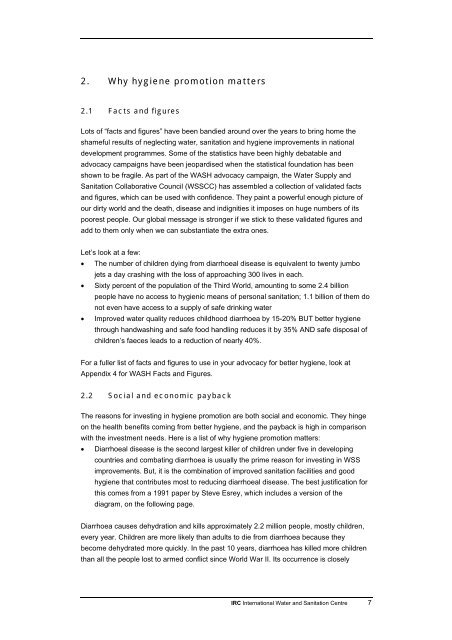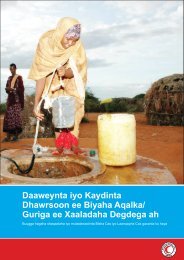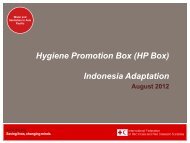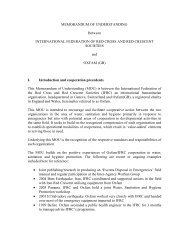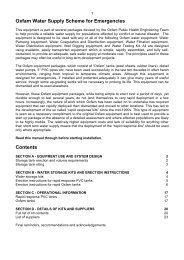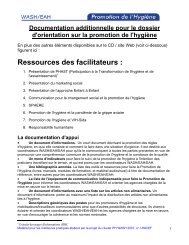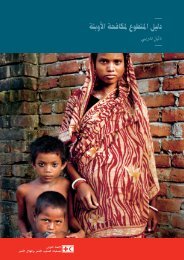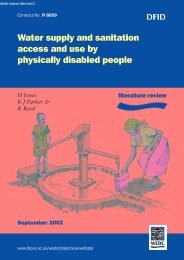Hygiene Promotion - IRC International Water and Sanitation Centre
Hygiene Promotion - IRC International Water and Sanitation Centre
Hygiene Promotion - IRC International Water and Sanitation Centre
Create successful ePaper yourself
Turn your PDF publications into a flip-book with our unique Google optimized e-Paper software.
2. Why hygiene promotion matters2.1 Facts <strong>and</strong> figuresLots of “facts <strong>and</strong> figures” have been b<strong>and</strong>ied around over the years to bring home theshameful results of neglecting water, sanitation <strong>and</strong> hygiene improvements in nationaldevelopment programmes. Some of the statistics have been highly debatable <strong>and</strong>advocacy campaigns have been jeopardised when the statistical foundation has beenshown to be fragile. As part of the WASH advocacy campaign, the <strong>Water</strong> Supply <strong>and</strong><strong>Sanitation</strong> Collaborative Council (WSSCC) has assembled a collection of validated facts<strong>and</strong> figures, which can be used with confidence. They paint a powerful enough picture ofour dirty world <strong>and</strong> the death, disease <strong>and</strong> indignities it imposes on huge numbers of itspoorest people. Our global message is stronger if we stick to these validated figures <strong>and</strong>add to them only when we can substantiate the extra ones.Let’s look at a few:• The number of children dying from diarrhoeal disease is equivalent to twenty jumbojets a day crashing with the loss of approaching 300 lives in each.• Sixty percent of the population of the Third World, amounting to some 2.4 billionpeople have no access to hygienic means of personal sanitation; 1.1 billion of them donot even have access to a supply of safe drinking water• Improved water quality reduces childhood diarrhoea by 15-20% BUT better hygienethrough h<strong>and</strong>washing <strong>and</strong> safe food h<strong>and</strong>ling reduces it by 35% AND safe disposal ofchildren’s faeces leads to a reduction of nearly 40%.For a fuller list of facts <strong>and</strong> figures to use in your advocacy for better hygiene, look atAppendix 4 for WASH Facts <strong>and</strong> Figures.2.2 Social <strong>and</strong> economic paybackThe reasons for investing in hygiene promotion are both social <strong>and</strong> economic. They hingeon the health benefits coming from better hygiene, <strong>and</strong> the payback is high in comparisonwith the investment needs. Here is a list of why hygiene promotion matters:• Diarrhoeal disease is the second largest killer of children under five in developingcountries <strong>and</strong> combating diarrhoea is usually the prime reason for investing in WSSimprovements. But, it is the combination of improved sanitation facilities <strong>and</strong> goodhygiene that contributes most to reducing diarrhoeal disease. The best justification forthis comes from a 1991 paper by Steve Esrey, which includes a version of thediagram, on the following page.Diarrhoea causes dehydration <strong>and</strong> kills approximately 2.2 million people, mostly children,every year. Children are more likely than adults to die from diarrhoea because theybecome dehydrated more quickly. In the past 10 years, diarrhoea has killed more childrenthan all the people lost to armed conflict since World War II. Its occurrence is closely<strong>IRC</strong> <strong>International</strong> <strong>Water</strong> <strong>and</strong> <strong>Sanitation</strong> <strong>Centre</strong> 7


